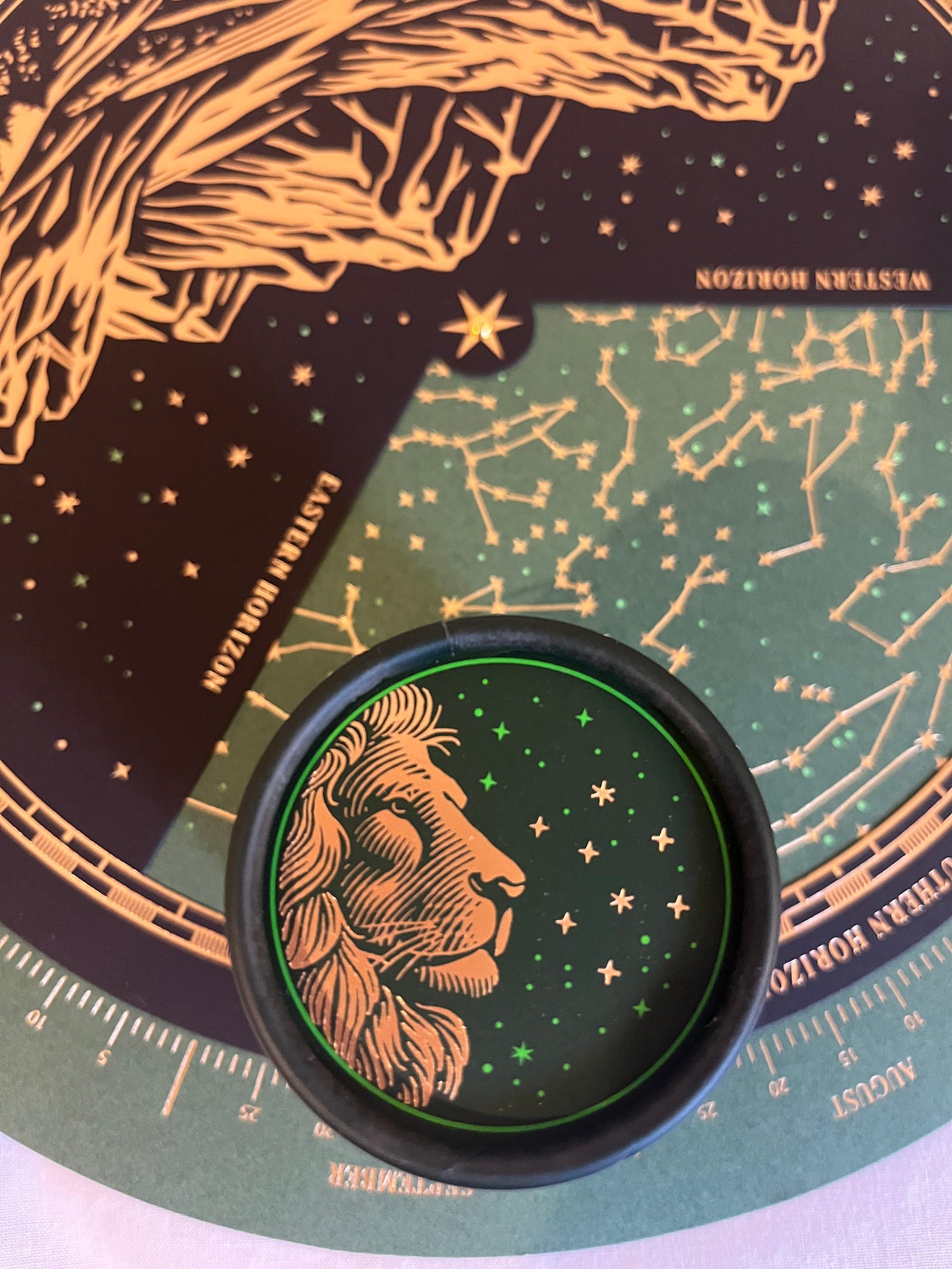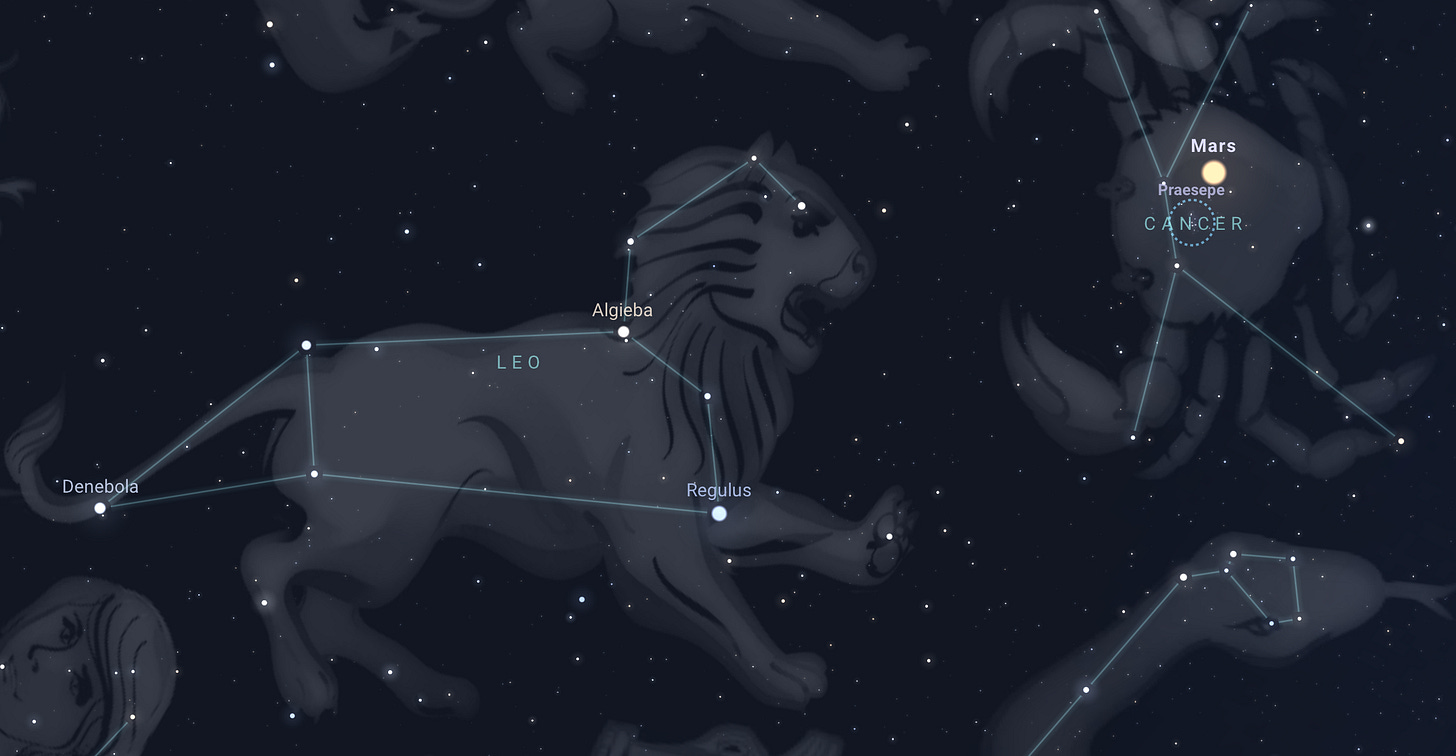
Let’s turn our attention to two constellations in the zodiac, one bright and regal, the other faint and subtle. But this year, the faint one has been embellished with a planetary bauble…
Our first constellation is a preview of the stars of spring-a promise of warmer weather in deepest winter. Pouncing out of the eastern horizon later at night is a big starry lion, his back, neck and head glittering, and a bright diamond marking his heart. One might be reminded of the Lion King when they see this constellation, but I think of Leo as Aslan in The Lion, The Witch and the Wardrobe, who roars away winter and brings spring on his paws. This is because the best time to see it is in March and April. Some say the phrase ‘In like a Lion, Out like a Lamb’ refers not to changeable March weather, but rather to the constellation Leo becoming prominent in the sky, and the Sun moving into Aries at the spring equinox.
One of the most dazzling of the zodiac signs, Leo resembles a crouching sphinx (or a cat in a ‘loaf’ position as I’ve seen it described!) and can be easily found rising in the east at about 10pm. The lion’s head is marked by a ‘sickle’ or curved line of stars, ending at the bright star Regulus.
Leo is an impressively old constellation, first noted in the Middle East thousands of years ago. This picture of stars was seen as a lion by the Babylonians, Indians, Persians, Egyptians, Syrians and Hebrews, as well as the Greeks and Romans. Some say the Sphinx of Giza in Egypt represents Leo. The sickle asterism is an old one too, noted by Central Asian peoples as a curved knife and the Celts as a sacred sickle used to cut mistletoe (a nice festive connection!) and the Chinese see the front part of Leo as a constellation called the Rain Dragon.
One myth said that the gods put the lion in the sky simply because it was perceived as the king of beasts, the top predator and the most formidable of animals. But a more famous Greek myth has Leo was the Nemean Lion, one of the creatures Hercules was sent to slay as part of his twelve labours. The lion’s hide was impervious to all weapons and the beast prowled the land, eating people in a state of insatiable hunger. Hercules, along with his assistant, found a way to kill the lion by strangling the animal, only then could the hide be removed, and from then on the lion’s pelt was worn by the hero to make him invincible.
The brightest star in the constellation is the diamond white Regulus, which means little king in Latin, it is also known as the Lion’s Heart, and Mesopotamian peoples were the first to call it the ‘star of kings’. It is located very close to the ecliptic meaning the Moon and planets can get close to it and even occult it. Some astronomers think that 2000 years ago there was a conjunction of Jupiter and Saturn, or Jupiter and Venus and Regulus, and this was the ‘Star of Bethlehem’. Jupiter was the king of the gods, Venus represented the divine feminine (and so the mother of God), and Regulus was astrologically linked to royalty, leadership and shining in a crowd. This star was considered one of four ‘royal stars’ in Persia that marked the seasons-with Regulus representing the summer solstice, and the Lakota call it the fireplace.
Regulus spins so fast that it bulges outwards, if it spun any faster it would tear itself apart. The star is 79 light years away, meaning the light we see left it in 1945, the year that marked the end of the Second World War. Sadly, the world is still full of needless war and in these uncertain times, it feels like yet more conflict is not too far. Maybe the light of Regulus can bring us the promise of peace?

Next, we turn to a lesser-known star cluster with a seasonal connection. The cluster, known formally as M44 (yes, this is another Messier object), is commonly called the Beehive cluster, probably because it resembles a swarm of bees. But another name for it is Prasaepe, which means the Manger. There are even two stars next to it called the Two Donkeys. These associations of the starry manger with attendant donkeys predate Christianity. It is thought to represent the manger of Dionysus, god of wine, and the donkeys he and his friend rode into battle (please don’t drink and drive, in cars or on donkeys…) but it seems very apt that this cluster reaches its peak at midnight at this time of year, both for the ‘manger’ and the ‘god of wine and good times’ associations!
The Beehive cluster is on the threshold of naked eye visibility-it can be seen without equipment if your skies are very dark-these stars are not as bright as the dazzling Pleiades. Ancient peoples did see it as a fuzzy patch in the sky-the Chinese associated the cluster with ghosts or spirits and likened it to a cloud of pollen. The Greeks called it ‘nebulous mass’ or ‘little mist’, and used its visibility to predict the weather. They said that when the cluster disappeared from sight but other stars were still visible, they believed it meant that bad weather was on the way. Now I’m no meteorologist so I can’t say if there’s truth to the claim, but it is possible that a change in humidity, caused by approaching rain, could obscure the Beehive. It was Galileo who first observed it with a telescope and found it was made of many stars.

The Beehive is located in Cancer the crab, the faintest of the zodiac constellations, but it has a lot of associations linked to animals that live in water and/or have hard shells or exoskeletons. To the Greeks, this was a crab that the goddess Hera sent to distract Hercules and pinch his heel as he was battling the many headed Hydra. Hercules crushed the crab, but Hera had a soft spot for the creature so she elevated it into the stars, along with Leo.
The Babylonians called it both a crab and a turtle, the Tibetans a frog, and the Egyptians called it the scarab god Khephri, the divine dung beetle who rolled the sun across the sky, which may be linked to the fact that this constellation is where the sun is located during the summer solstice. The Celts might also have seen it as a crab, or as a raven.
To find this shy celestial crustacean and the buzzy cluster within, this year we have help from a very bright planet. Rising at about 9pm is a distinctly red dot, shining without twinkling (do not confuse it with the stars Aldebaran and Betelgeuse-this one is brighter). You are looking at Mars. Point your binoculars or telescope just below Mars, and you might see a scattering of stars. Congratulations, you’ve found the Beehive!
Later this month the bright Moon will pass both Mars and the Beehive, making it harder to see the cluster, so now’s the time to observe it.
This cluster is made of over 1000 stars is 500-600 light years away, so you may well be looking at the light that left when Copernicus came up with his revolutionary theory that the Earth is not the centre of the universe and orbits the Sun. These stars are older than the Pleiades, a mix of young stars with older red giants and white dwarfs. Think of it as a festive family gathering of all generations-fitting for the winter holidays!

Prompts:
Leo’s prompt is inspired by the lion’s pride, and a lyric by M People: what have you done today to make you feel proud? And I don’t mean proud as a brag, a boast, an ‘I’m better than you’ attitude, but something that makes you glow from within, like the sun, warms the heart. It doesn’t need to be big, it can be something like writing a card or message to someone you love. Or maybe achieving a deadline. Or getting those presents wrapped, the cards sent. Small things count.
The Beehive’s prompt: what ‘honey’ are you hoping to harvest for the colder months-ie, where can you find glimmers of gold and moments of sweetness? These are positive things that help make the cold dark months pass by smoothly.



